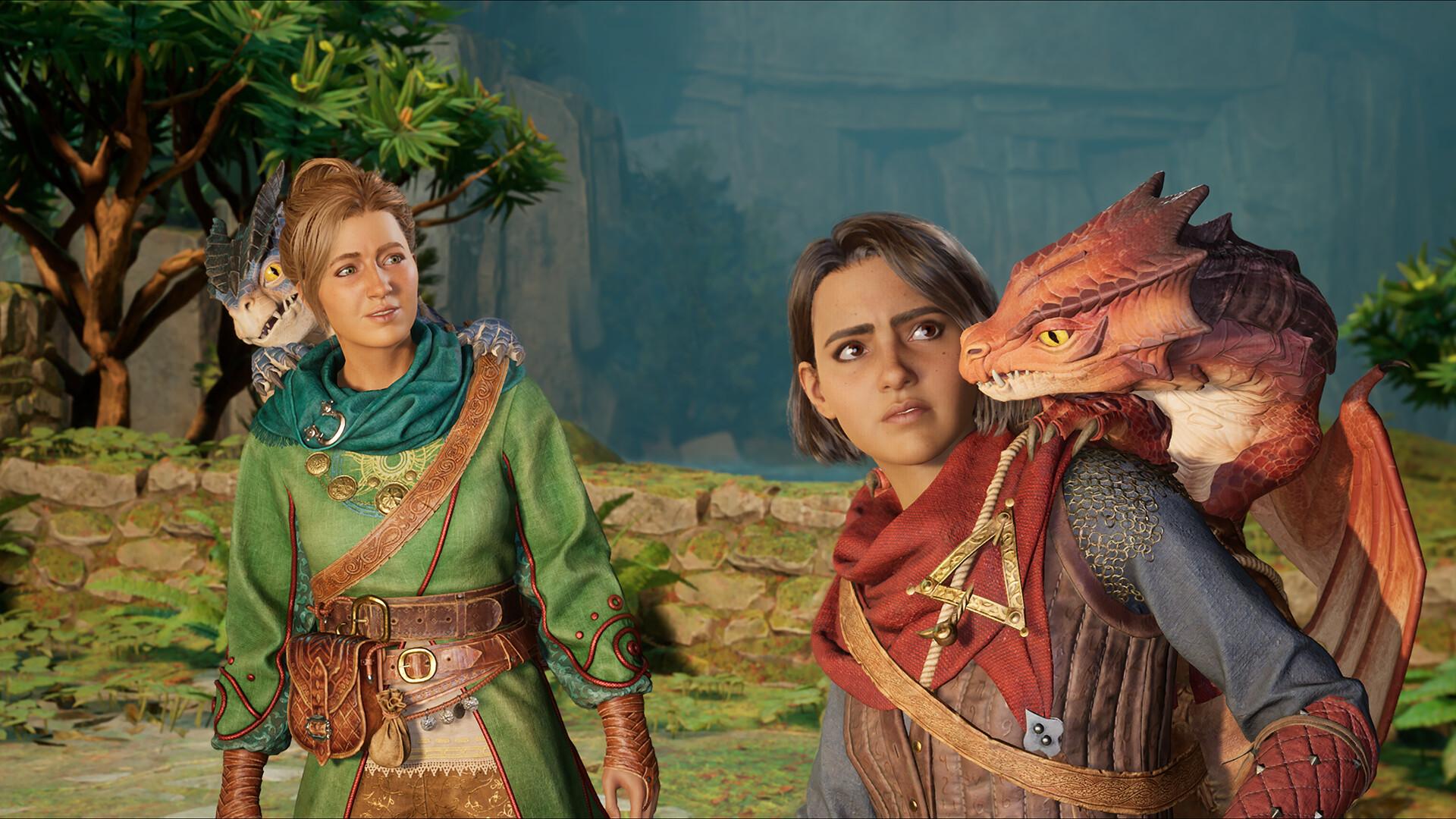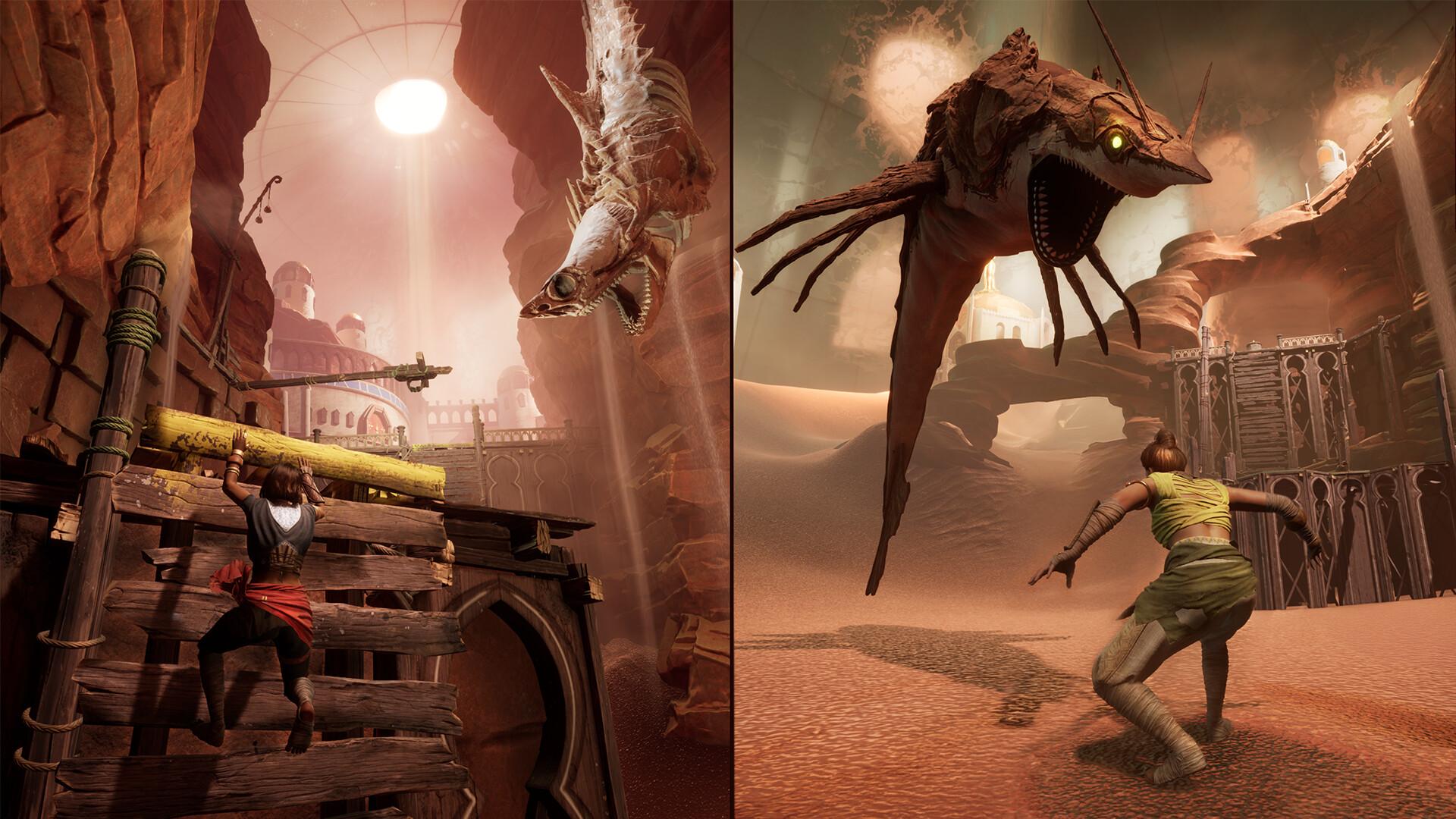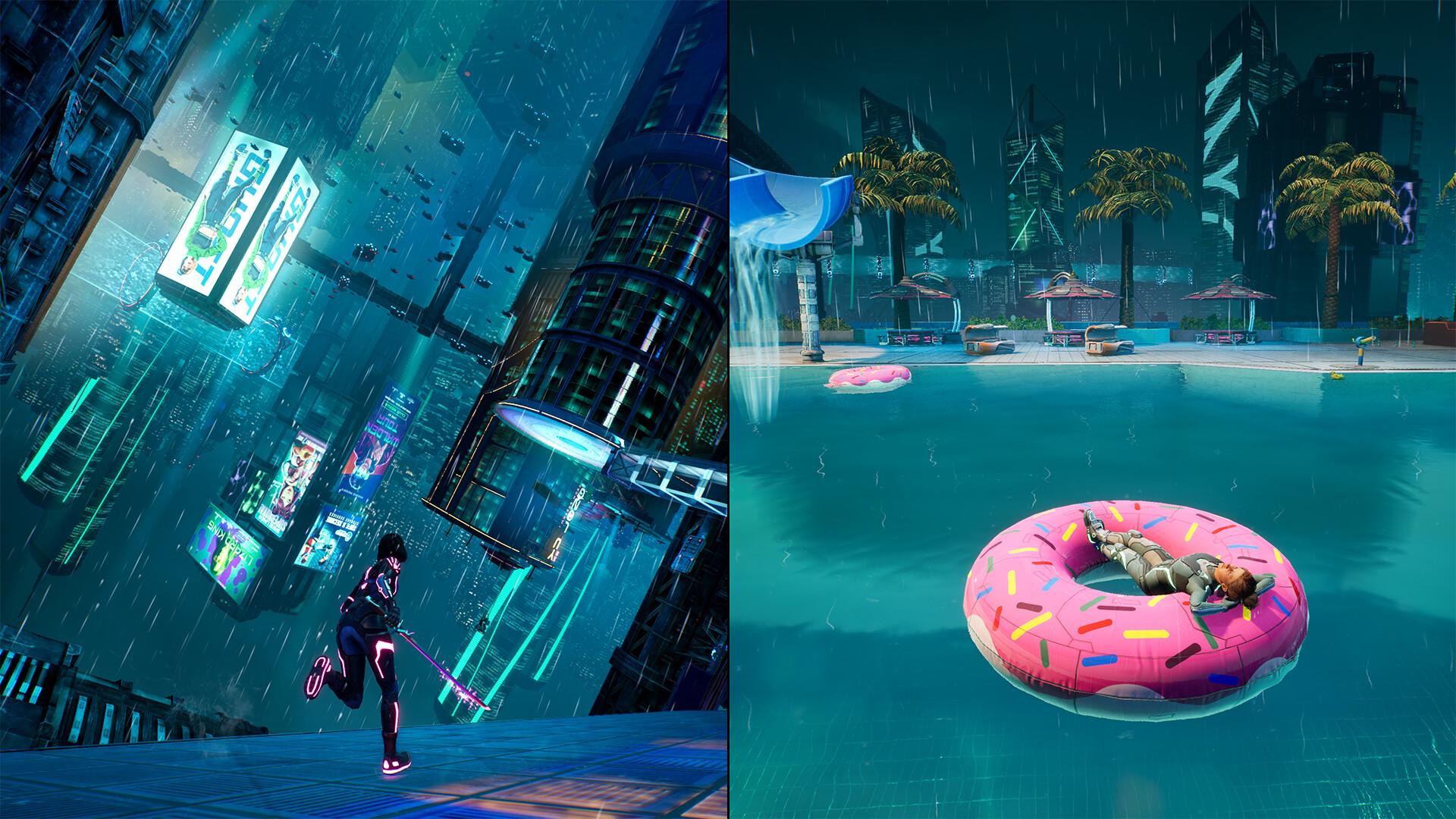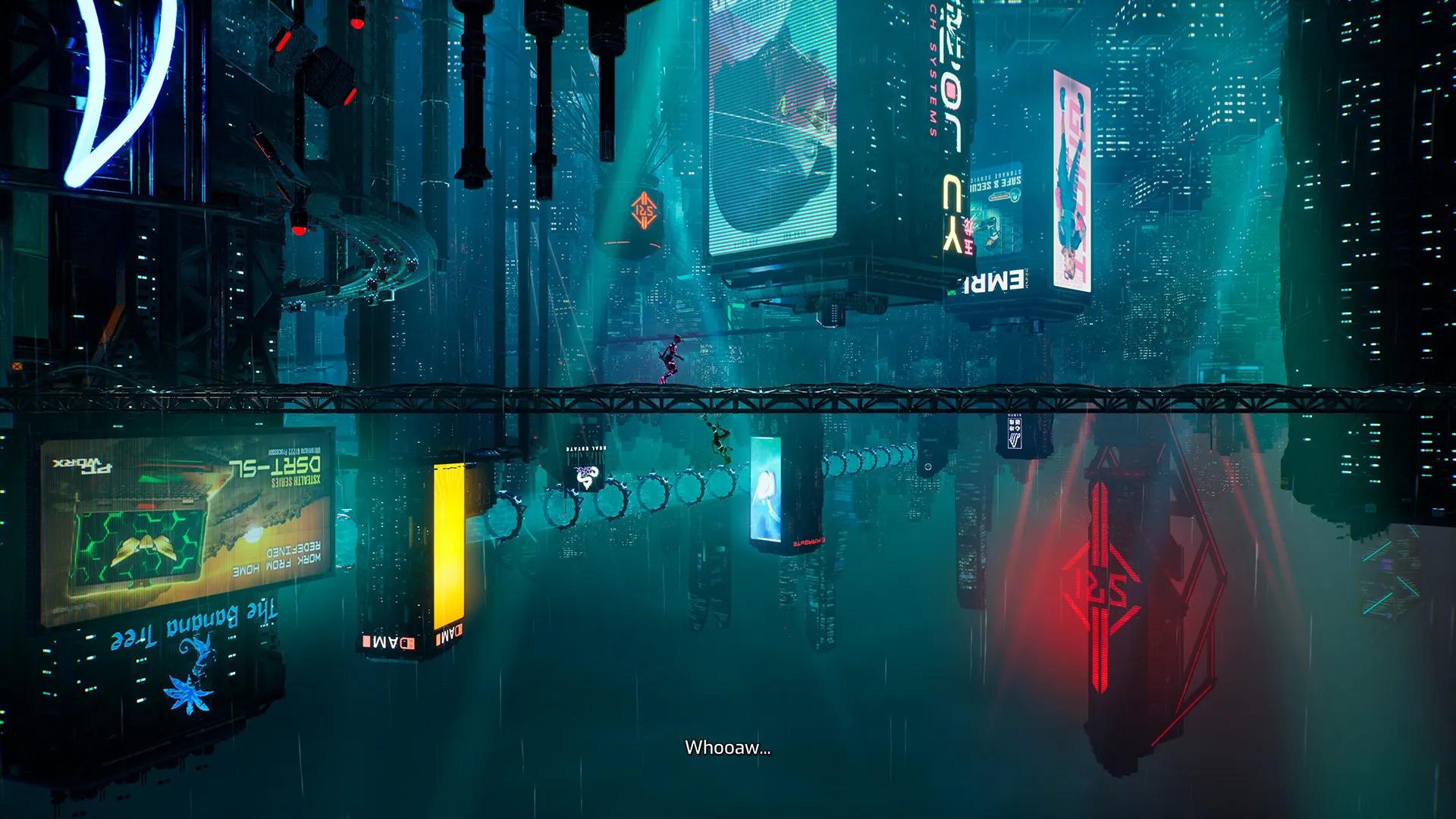
by
Lee Mehr
, posted 2 hours ago / 307 Views
Reviewer’s Note: Though I try to keep them limited, certain observations mean I have to touch on both GAMEPLAY & STORY SPOILERS here. I emphasize gameplay as well because part of the fun could be in discovering what oddball concept the game throws at you. Read on at your own risk.
Because why bother looking at It Takes Two, 2021 Game of the Year front-runner and multi-million seller, and then trying to emulate such a successful formula? Approximately four years have passed since Hazelight Studios’ aforementioned title burst onto the scene to tremendous fanfare and few games like it have released since then. To Director/Writer Josef Fares and the team’s credit, it’s not like anyone can sit down and whip up a mandatory two-player co-op game on a whim. Hell, on the publishing side, imposing such a stricture – alongside only demanding one player own the title – looks like a guaranteed financial dud. But that’s the risk & reward of going off the beaten trail: having a unique design ethos enables Split Fiction to be yet another outstanding example of the medium’s potential.
Our dual protagonists are Zoe and Mio: a pair of aspiring fantasy and sci-fi writers (respectively) hoping to net their first publishing deals. Despite their disparate personalities, a layman would anticipate they’d get along smashingly in sharing similar hopes and broad genre enthusiasm. But, convenient for this story’s sake, fantasy and sci-fi fans are at loggerheads with one another for some arbitrary reason. They soon have bigger fish to fry because tech giant EA Studios Rader Publishing isn’t interested in signing a book deal; instead, using what’s simply called ‘The Machine,’ CEO Andrew Wilson J.D Rader hopes to strap these unwitting creatives in and suck up all of their creative ideas to repackage and sell. Did I mention this is published under the EA Originals label?

Growing uncomfortable with being placed into this strange device, Mio’s last-second withdrawal results in her accidently stumbling into Zoe’s bubble-pod. Now, due to some plot conveniences, they’re enmeshed together, venturing through each other’s stories while trying to escape. Exploring the contrasts between them – Zoe through gritty dystopian sci-fi and Mio through softer fairy tales – plays a big part in keeping your attention. Seeing that disparity and the sheer scale of these worlds materialize in real-time is a constant spectacle, which is all the more impressive coming from a middle-market studio.
It’s also easy to forgive that, as far as locations go, we’ve seen most of them Xeroxed over the years. Hell, before dropping into a high-tech chemical factory, Zoe & Mio’s red and blue squads are given a hearty pep talk by Discount Sergeant Johnson in a Discount Pelican. But these familiar settings work because the game proper is about juggling new gameplay concepts at a rapid-fire pace. There’s no time for belabored anecdotes like War & Peace or expansive world-building, and the game would be weaker if it tried. What’s here instead is a rather basic structure: excluding the beginning and finale, most of the campaign is split into six different levels (three for Zoe, three for Mio) and hops between them each time. Within these bigger sections are three of the other characters’ optional Side Stories: half-formed ideas that take roughly 10 minutes each to complete.
Although I prefer It Takes Two’s slate of competitive side activities, Side Stories are not only narratively uncomfortable – by revealing just how effective The Machine is at scouring their brains for half-remembered concepts – but they also speak to Split Fiction’s ecstatic eagerness to dole out idea after idea after idea after idea. By the time I’m left asking “am I going to savor this mechanic for long?” another silly one-off gag or its best idea (yet) is shoved down my gullet. Sure, these two are typically playing it safe with their preferred genre’s tropes, but they’re so enthusiastic to juggle them. And that can’t help but be infectious.

Such a deluge of new stuff naturally means you’ll occasionally fumble along the way. Fortunately, the show goes on unless both parties hit a fail state within a limited time window; oftentimes whoever ‘dies’ can resurrect faster through some button-mashing, other times the one left standing has to reach an invisible checkpoint. It’s courteous with unlimited retries – and your unseen regenerative health bar is quite forgiving – but that approach naturally melds with its unique co-op demands. Remember: you’re never alone here. The design’s antsy attitude corresponds to your own mentality in not wanting to keep your partner waiting.
That understanding is also reflected in Mio & Zoe’s mechanical baseline. Stripping away the power-ups and special abilities, their platforming abilities come down to double-jumping, air-dashing, dashing up poles, and wall-running with the sort of generous magnetism seen since Uncharted. It’s a simple foundation, but competently executed. Outside the rare instances of misregistered ledge grabs or scaling the camera too far back, Hazelight is neck-and-neck with the putative leader of platformer polish: Nintendo. That’s nothing short of impressive when considering this dual-character template has to simultaneously render them within gorgeous backdrops at a consistent 60fps; moreover, I scarcely recall any technical issues once my online partner and I got into a lobby.
When placing them on a scale, it’s astounding how close together Hazelight’s current and last game are in terms of mechanical ingenuity. Admittedly, I’m a tad more preferential towards Two’s approach with the practical. Infusing magical properties into workshop items feels more unique than bestowing a cybernetic blade and gravity whip – even though the game design in both cases is equally inventive. The Machine/The Matrix means every level gets to be drawn like a blank canvas, which – ironically – makes it easier to spot where its variegated concepts were stolen from. There are a lot more besides the aforementioned ‘Not Halo’ references, yet they don’t feel soullessly imitative. The quick reverent nods to Donkey Kong, Portal, and many more are purposively refashioned as part of a larger whole.

When the action and story slow down, however, that also reveals its weakest quality. Sure, from the outset, the premise of absorbing what are often bog-standard sci-fi or fantasy ideas begs the question as to why these two are here. Almost as if revealing why great action beats as gameplay concepts doesn’t quite translate to being the next Ursula K. Le Guin. Then again, it’s not hard to analyze and consider that this reveals the creatively vacuous state of the Rader altogether. Or perhaps testing this experiment first on a hapless group of financially-strapped unpublished writers – those who’re mostly likely to recycle their inspirations – was Rader’s best option for a trial run. Even though the wider narrative arc is in service to big spectacle moments, there is more to it than simply dumping fan service and explosions for their own sake.
On the other end, the two leads aren’t quite as easy to defend as the out-there premise. Outside of the overwritten tidbits so typical of modern blockbusters – empty “what a view!” remarks to each other and whatnot – Sebastian Johansson and Josef Fares also leaned in too much on ham-fisted dialogue. “You think each story we write tells a part of ourselves?” Mio, for crying out loud, you’re in your early 20s. And am I really supposed to believe a fantasy enthusiast like Zoe doesn’t have one Teen-rated side story about… “redeeming” an attractive vampire or werewolf? Kidding aside, I have to admit that I still genuinely rooted for these characters as it progressed. Even if the script is too cringe-inducing and clumsy for its own good, how their greatest mental obstacles are tackled alongside the tech giant B-plot makes for a delightfully insane finale that I wouldn’t dare change.

It should also be emphasized that, on top of its dozen-hour runtime (made longer if including Side Stories) for $50 retail, Split Fiction sticks to the developer’s past pro-consumer policy. Since releasing A Way Out, only one player has to actually own each Hazelight game to play with a partner; moreover, the free Friend Edition is now also fully cross-platform, meaning any buddy simply needs a consistent internet connection. The more I think about it, it’s quite staggering to consider that someone could play through this team’s entire oeuvre without paying a single penny and it wouldn’t count as piracy. When you weigh these elements alongside the inherent replay value of being the other character – experiencing her unique perspective and abilities – there’s simply no other comparison in today’s market.
Like It Takes Two, Split Fiction will go on to be one of the Rosetta Stones against which any other specialized co-op game will be judged. How it measures up to Hazelight’s previous is an exciting quandary all of its own. On the one hand, I may lean towards Two’s more Toy Story-esque logic and the creativity derived from that; on the other, I don’t anticipate anyone topping this spectacular finale for years to come (though I’ll be ecstatic to be proven wrong). Even after its few storytelling missteps, or the rare case of platformer imprecision, all that mattered when the credits rolled was the absolute joy encased within this experience.
Contractor by trade and writer by hobby, Lee’s obnoxious criticisms have found a way to be featured across several gaming sites: N4G, VGChartz, Gaming Nexus, DarkStation, and TechRaptor! He started gaming in the mid-90s and has had the privilege in playing many games across a plethora of platforms. Reader warning: each click given to his articles only helps to inflate his Texas-sized ego. Proceed with caution.
This review is based on a digital copy of Split Fiction for the XS, provided by the publisher.
More Articles





